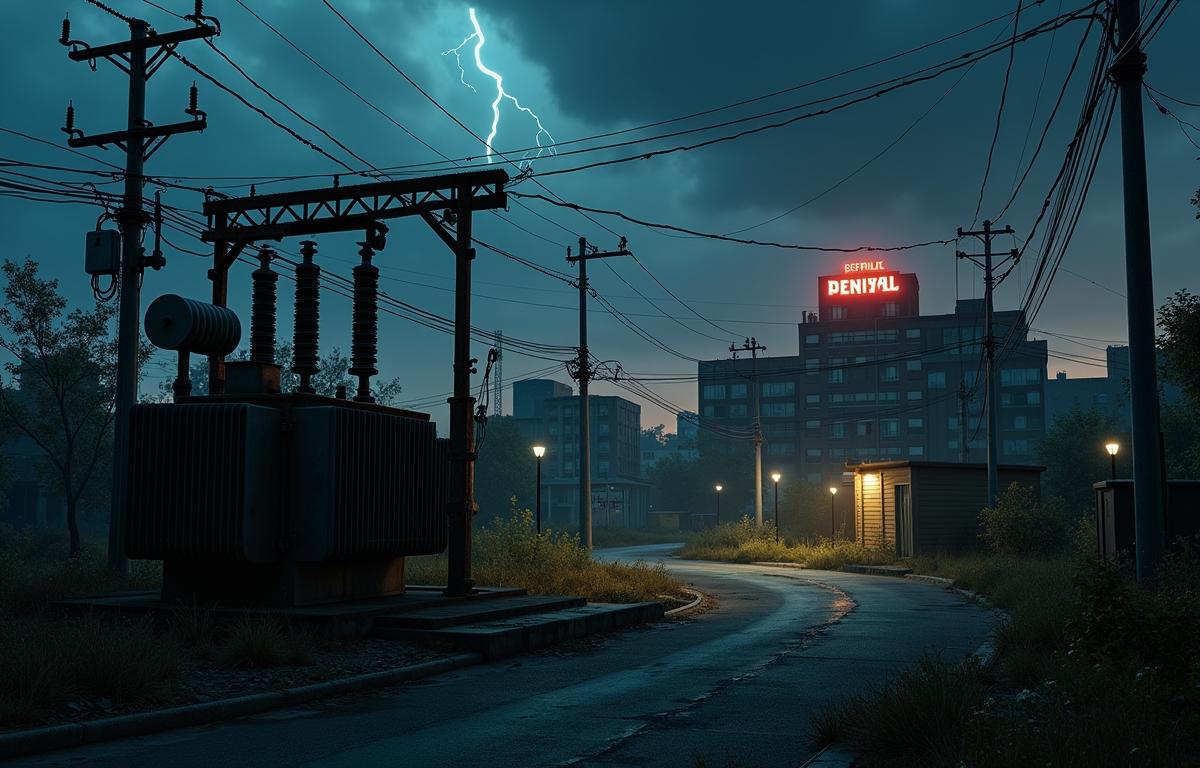Everyday routines and commerce can be disrupted due to grid failures causing power outages. Whether it’s a brief flicker of lights or a widespread blackout lasting days, few things remind us of modern dependency on electricity more than a sudden outage. Many places around the world have experienced these disruptions, and each incident highlights complex vulnerabilities in our energy infrastructure. It’s not only about restoring power quickly but also about identifying weak spots to prevent problems in the first place. By exploring the technical, environmental, and human aspects of these disruptions, we can learn to keep our power networks stable.
Losing electricity impacts people at all levels households without air conditioning during a heatwave, hospitals forced to run on backup generators, and industries pausing critical operations. As the world grapples with rising energy demands, it becomes even more important to focus on ways to make the power system more resilient. Utility companies and governments often coordinate to address root causes, but durable solutions demand continuous research, updated technology, and community involvement. The sections below look into multiple triggers and potential strategies, shedding light on the various ways to handle power interruptions so that the grid stays healthy.
Causes of power interruptions
A power grid is an interconnected system of generation, transmission, and distribution, and it must be finely balanced. When that balance is upset, even slightly, blackouts can happen. Regular maintenance and strategic planning reduce the likelihood of failures, yet unexpected events still create issues. In many cases, a single failure can produce a domino effect that leads to regional or even national-level outages.
Still, the reasons behind major failures are not always straightforward. Sometimes they stem from natural phenomena that no one can fully control, while other times they arise from easily preventable mistakes. Below are key contributors that can strain or break these intricate networks:
Aging infrastructure
Many regions still depend on power lines and substations that were built decades ago. Older transformers, circuits, and other components wear down, making them less efficient and more prone to malfunction. Maintenance schedules help, yet cracks can form in insulation, cables can corrode, and hardware can lose reliability over time. When an older piece of equipment does fail, it can send a surge or fluctuation across multiple lines, causing a cascading breakdown. Replacing outdated parts is expensive, but neglecting them can lead to sudden collapses that disrupt entire cities.
Upgrading aging equipment also helps utilities keep pace with modern energy requirements. New materials last longer and can handle higher loads, which becomes crucial as people plug in more devices and industries scale up. With advanced insulation, better cooling systems, and improved control technology, today’s infrastructure can better adjust to surges in demand. This modernization is not an overnight task, but it’s a significant step toward more stable power delivery.
Extreme weather events
Storms, hurricanes, floods, and heatwaves frequently damage transmission lines, leading to blackouts that can linger for days. Lightning strikes can knock out transformers, high winds can topple utility poles, and heavy ice can weigh down lines until they snap. Outages from storms stress how little control we have over nature, but there are ways to bolster the grid against such challenges. Raised substations, buried cables, and additional insulation can reduce the impact of nasty weather, though these steps involve considerable capital investment.
Lightning protection is one of the more common strategies. Devices like lightning arresters help redirect dangerous electrical spikes, protecting sensitive equipment down the line. Utilities can also prune or remove nearby vegetation to limit the risk of falling branches, a major cause of disruptions during strong winds. While no plan fully prevents every weather-related breakdown, sensible planning and periodic inspections can lessen the damage and speed up recovery.
Human error and operational issues
Sometimes a single misstep can create bigger issues than any failing machine. If control-room staff misread data or react too slowly during a crisis, the system can become unstable. In some cases, human mistakes happen during maintenance, where a critical circuit might be taken offline without proper backups in place. Training and robust protocols can address these weak points. Thorough simulations and emergency drills make operations smoother, especially when every second counts.
Software failures and system misconfigurations also pose risks. Automated systems manage a substantial portion of grid operations, determining the best flow of electricity across countless miles of wires. When these systems are poorly programmed or not frequently updated, small errors can cascade into large-scale outages. Regular software patching, routine audits, and layered oversight of automated processes help minimize these vulnerabilities.
Effects on communities and industries
Beyond the inconvenience of no lights or air conditioning, power outages carry more serious repercussions. Hospitals rely on electricity to run life-saving equipment and to maintain adequate lighting. If backup generators fail or lose fuel, the healthcare environment faces potentially dangerous conditions. Nursing homes, dialysis clinics, and urgent-care centers also depend on stable power to keep patients alive and well. When the grid goes down, these places must shift quickly to emergency power, hoping they have enough resources until the grid is restored.
Industries can lose millions of dollars in just a few hours. Manufacturing lines grind to a halt, data centers risk data corruption, and banks can’t complete transactions. In an era where everything is tracked digitally, every minute lost equals potential revenue drops. Prolonged outages may force entire communities to relocate temporarily, as essential city services and water purification systems might not function without electricity. This broader disruption underlines how vital steady power truly is for modern living.
Monitoring and maintenance
Routine checkups and cutting-edge tools can make the difference between a minor flicker and a major blackout. Monitoring systems keep a digital eye on transformers, switches, and load centers, collecting real-time data. If a particular transformer is running hot or a surge in demand suddenly occurs, control centers can address the situation before it escalates. Particularly busy corridors, like those in population-dense regions, require extra layers of monitoring.
Predictive technology
Predictive maintenance leverages machine learning and analytics to foresee component breakdowns. Historical data on heat buildup, vibration patterns, and fault logs can feed an algorithm that hints at when a specific part is likely to fail. Instead of waiting for problems to surface, utilities can repair or replace the part to avoid unexpected outages. With these analytics, equipment is serviced more efficiently, in many cases while still active, minimizing disruptions to customers. These tools are evolving, and as they do, the grid becomes smarter about responding to emerging or hidden threats.
Workers also rely on remote sensors and drones to inspect lines and equipment in hard-to-reach areas. Drones can capture detailed images of transmission towers or detect hot spots and cracks invisible to the naked eye. Combined with software that compares those images against known flaw patterns, these inspections become both faster and more thorough. Whether in a chilly mountain pass or in a scorching desert, drones and intelligent apps can gather data without endangering human lives, speeding repairs substantially.
Improved training and workforce
Technology alone doesn’t solve every issue; well-prepared human operators remain essential. Grid operators must interpret readings, make judgment calls, and coordinate teams of technicians. Training covers both routine tasks and high-pressure scenarios, teaching staff how to recognize anomalies, handle surges in demand, and respond to disasters. Live drills, complete with simulated system failures, help identify knowledge gaps and strengthen decision-making skills under stress.
The workforce also needs specialized skills to maintain and upgrade modern power infrastructure. New recruits often study enhanced automation protocols, cybersecurity measures, and the intricacies of renewable energy systems. By blending experienced veterans with fresh perspectives, utility providers and grid managers encourage continuous improvement. This focus on education and practical expertise ensures human oversight remains strong in an era increasingly guided by digital controls.
Steps toward a more resilient energy network
As populations grow and a variety of power sources come online, stabilizing the grid becomes more challenging. Renewable energy, while beneficial in the long run, can introduce fluctuations in supply that require advanced balancing strategies. Energy storage technologies, such as batteries and pumped hydro, help smooth out these dips and spikes. Investing in microgrids is also gaining ground for localized solutions that can run independently if the main network fails.
Risk assessments that factor in everything from storm frequency to equipment lifespans offer a more targeted approach to upgrades. While no strategy can guarantee zero blackouts, a proactive stance goes a long way. By making better infrastructure choices, employing modern monitoring methods, and training a skilled workforce, the power system can withstand setbacks, reduce the scale of outages, and restore service faster when issues arise. This forward-thinking approach keeps people safe, economies stable, and daily life humming along, even when the unexpected challenges our energy landscape.


